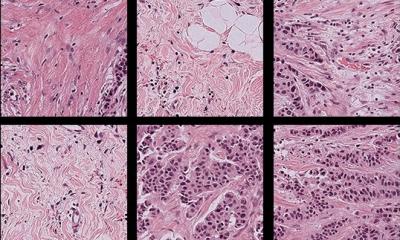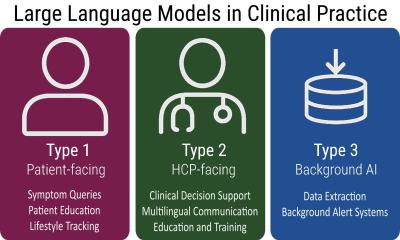
Image source: Adobe Stock/eddows
News • Cancer & Artificial Intelligence
AI algorithm for better detection of oropharynx cancer
For patients with human papilloma virus (HPV)-associated oropharynx cancer, assessing the presence of cancer cells beyond the lymph nodes, or extranodal extension (ENE), is critical in determining proper treatment. However, ENE is often challenging to detect on imaging pre-treatment, which can lead to an escalation in treatment resulting in greater toxicity and worse quality of life outcomes.
A new study by investigators at Brigham and Women's Hospital, a founding member of the Mass General Brigham health care system, and Dana-Farber Brigham Cancer Center found that an artificial intelligence (AI)-based algorithm was superior at detecting ENE compared to four expert head and neck radiologists in a large, multicenter oropharynx cancer clinical trial. This technology is now set to be used in a clinical trial to determine if it results in improved treatment outcomes. The team's results are published in The Lancet Digital Health.
Oropharynx cancer and the risk of ENE
"HPV-associated oropharynx cancer is now the most common type of this cancer. And while these patients tend to respond very well to surgery or chemotherapy and radiation, there's been a lot of interest in trying to figure out ways to de-escalate treatment, so patients can have fewer side effects and long-term issues that reduce quality of life," said first author Benjamin Kann, MD. "An appealing strategy is to use a type of minimally invasive surgery for these patients, called trans oral robotic surgery (TORS), instead of seven weeks of combined chemotherapy and radiation."
However, the presence of ENE is a risk factor for the cancer to return after surgery and for lower rates of survival overall, making patients with ENE poor candidates for TORS. "If ENE is found after surgery, those patients still need to receive a long course of chemotherapy and radiation, or trimodality therapy, which is associated with the worst complications and quality of life outcomes," said Kann.
Historically, ENE has been very difficult to detect using traditional diagnostic imaging, so there have been a good number of patients who still require trimodality therapy, despite screening. "The unmet need and the impetus for using AI in this study was to see if we could do a better job at predicting whether ENE was present or not on a CT scan prior to treatment, so we can help select the appropriate patients for surgery or for chemotherapy and radiation," said Kann.
The validation and benchmarking study framework

(A) The previously developed deep learning algorithm was retrained on a combined, multi-institutional dataset from three sources to predict probability of nodal metastasis and ENE on a node-by-node basis.
(B) The model was locked and tested on a curated dataset of 313 lymph nodes from 178 patients enrolled on the E3311 de-escalation trial for patient withs human papillomavirus-associated oropharyngeal carcinoma, a trial that specifically excluded radiographic matted nodes or overt clinical ENE. Four expert head and neck radiologists from National Comprehensive Cancer Network comprehensive cancer centers, and with access to a validated educational guideline for radiographic ENE criteria, individually reviewed the lymph nodes, and made a prediction of node positivity or ENE on a forced Likert scale. ENE classification performance was compared between the deep learning algorithm and the radiologists, with a primary endpoint of area under the receiver operating characteristic curve. 3D=three dimensional. AUC=area under curve. ECOG-ACRIN=Eastern Cooperative Oncology Group and the American College of Radiology Imaging Network. ENE=extranodal extension. ROC=receiver operating characteristic.
Great accuracy of the AI algorithm in detecting the presence of ENE
When we applied the algorithm to this population to see how it would have done in in predicting ENE, we found that it performed well with a high degree of accuracy - better than all four expert head and neck radiologists.
Benjamin Kann
The team had already developed a deep AI algorithm that was trained to detect ENE and showed a high level of accuracy in several datasets. For this study, the team conducted a retrospective evaluation of the AI algorithm's performance, using pretreatment CTs and corresponding surgical pathology reports from ECOG-ACRIN Cancer Research Group E3311, a multicenter, phase 2 de-escalation trial.
"What was important about this study is it tested the algorithm in the context of a very large randomized clinical trial, where patients who were enrolled, by definition, were supposed to be screened out for having ENE, and yet a significant portion still ended up having ENE," said Kann. "When we applied the algorithm to this population to see how it would have done in in predicting ENE, we found that it performed well with a high degree of accuracy—better than all four expert head and neck radiologists.
"The main benefit seems to be an increase in sensitivity, or a lower percentage of missed ENE," said Kann. "Ideally, better recognition of ENE in pre-treatment would result in a lower rate of trimodality therapy and improved quality of life for patients."
These findings suggest that integrating this AI algorithm into the clinic may give physicians more accurate information about the presence of ENE, and determining which patients may be best served by surgery or with chemotherapy and radiation.
Source: Brigham and Women's Hospital
24.04.2023










